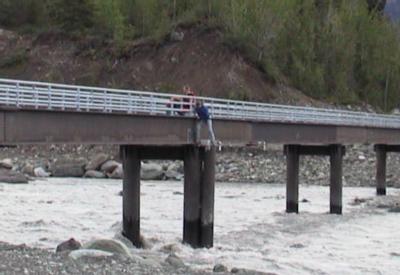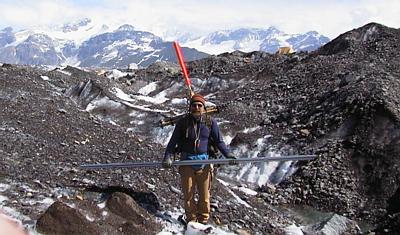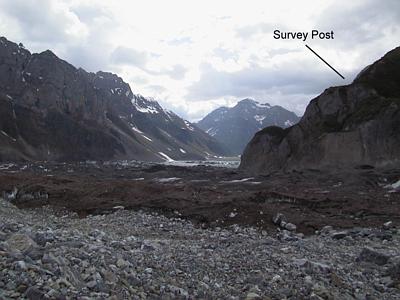14 July, 2000
July 14, 2000
News from the glacier………….. PSU grad student Don Lindsay and I moved the
drill 50 meters from its position a day ago and started a new hole.
Actually, this did not happen until Don made some repairs on the
diesel-powered heating unit. It has been breaking down on a regular basis.
It seems that the electrodes get wet from all of the moisture in the air (the
weather has been wet and slimey the past few days). The electrodes provide a
spark that fire up the burners that heat the water. Drilling was not very
successful today. Yesterday we pushed a hole to 240 meters. Today, Don only
got to 80 meters. As with before, the drill tip advances to a certain point
and then does not go any further. At the former drill site it was easy to
tell what got in the way - it was rocks. Here there does not appear to be
any rocks. We are a bit baffled. While Don drilled, I lowered the borehole
video camera into the 240 meter hole from yesterday. The walls of the
borehole were obviously a lot cleaner than at our previous site - white and
clear ice was observed for most of the distance down the hole. There were
virtually no rocks observed in the walls of the hole. I managed to get the
camera down to 239 meters, and then it got stuck in a notch on the side of
the hole. Try as I may, I could not get the lens to advance any further. By
the way, 240 meters is quite a distance - about 800 feet. I did get some
footage of some englacial passageways - most likely crevasses.
News from the lake…………….. Surveyor Dennis Trabant has been keeping tabs on
the lake level since PSU grad student Michelle Cunico joined us on the
glacier and PI Joe Walder went home (they originally spent 10 days at the
lake observing and instrumenting it). We got news from Dennis this evening
that the rate of rise was half of the usual today - only 8 inches. PI Andrew
Fountain viewed this as good news, even though he admitted that with the
cooler weather of the past few days the discharge from Hidden Creek into the
lake could be less. We are all ready for the lake to go………. After two weeks
of hard work drilling and placing instruments, we are ready for some action.
News from the stream……………… Dennis Trabant has also been in communication with
the stream team that is doing stream discharge measurements of the Kennicott
River where it emerges from the glacier. They have been gathering a good
baseline of stream discharge data for the past two weeks. They have also
been taking water samples to measure the concentration of various elements
and minerals. They also placed a pressure transducer into Lake Eerie. Lake
Eerie is another lake that is hydraulically connected to the subglacial
drainage system of the Kennicott Glacier and is located very near to the
snout of the glacier. Last year during the outburst flood it filled with
water very rapidly and then drained. At any rate, the stream team (from U.C.
Santa Cruz - Bob and Suzanne Anderson, and grad students Erin Kraal and
Sharon Longacre) is also ready for the flood and are tiring of the wait as
well.
We are running low on fuel to power the drill. We are not yet sure what we
will be doing tomorrow…………..

PI Suzanne Anderson places a data logger (gray box at her feet) atop a stilling well at the Kennicott Bridge. The stilling well looks like an additional piling, but does not serve a structural purpose for the bridge. It is hollow and stills the water from the rushing river so that an "average" surface elevation can be electronically measured.

Dennis Trabant is loaded down with survey stakes, reflectors, and a drill to put holes into the ice to place the stakes. Dennis placed a total of 21 stakes with reflectors out on the ice dam prior to the start of his survey. The placement of stakes took Dennis 5 days and involved hiking over dangerous terrain.

This picture shows the location where Dennis Trabant is surveying. The survey post, and his camp are on the second bench on the bluff in the right of the photo. Dennis has a view of the lake as well as the ice dam. He is tracking the movement (both vertical and lateral) of the glacier as well as the change in the surface elevation of the lake.

Contact the TEA in the field at
.
If you cannot connect through your browser, copy the
TEA's e-mail address in the "To:" line of
your favorite e-mail package.
|
